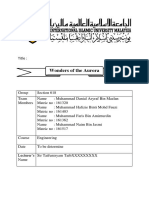0 ratings0% found this document useful (0 votes)
86 viewsWhat Is An Aurora?: Project Proposal Topic: Aurora (Aurora Borealis and Aurora Australis) Description
Aurora is a natural light display that occurs in the sky near the North and South Poles. It is caused by collisions between charged particles from the sun that enter the earth's atmosphere and collide with gas molecules, exciting them and causing them to emit colorful light. The lights can appear in shades of green, red, blue, violet, pink and white and are constantly changing shape. They occur when electrons and ions from the sun interact with the earth's magnetic field and collide with atmospheric gases like oxygen and nitrogen in the ionosphere.
Uploaded by
Aries Fernan GarciaCopyright
© © All Rights Reserved
Available Formats
Download as DOCX, PDF, TXT or read online on Scribd
0 ratings0% found this document useful (0 votes)
86 viewsWhat Is An Aurora?: Project Proposal Topic: Aurora (Aurora Borealis and Aurora Australis) Description
Aurora is a natural light display that occurs in the sky near the North and South Poles. It is caused by collisions between charged particles from the sun that enter the earth's atmosphere and collide with gas molecules, exciting them and causing them to emit colorful light. The lights can appear in shades of green, red, blue, violet, pink and white and are constantly changing shape. They occur when electrons and ions from the sun interact with the earth's magnetic field and collide with atmospheric gases like oxygen and nitrogen in the ionosphere.
Uploaded by
Aries Fernan GarciaCopyright
© © All Rights Reserved
Available Formats
Download as DOCX, PDF, TXT or read online on Scribd
You are on page 1/ 1
Project Proposal
Topic: Aurora (Aurora Borealis and Aurora Australis)
Description:
What is an Aurora?
Aurora is a natural phenomenon that displays colorful lights in the night sky. Auroras usually
occurs in the northern and southern latitudes. Frequencies decrease as an area becomes nearer to the
equator.
Those occurring in the
northern latitudes are called aurora
borealis or northern lights while those
occurring in the southern hemispheres
are called aurora australis or southern
lights. Auroras appear in various colors
and
continually-changing
shapes.
Usually, they are milky greenish color.
Others are red, blue, violet, pink and
white.
What causes Aurora?
The occurrence of aurora explains and can be explained by the electrical connections between
the earth and the space, specifically the sun. Perpetually, the sun emits electrons and other particles
which travel through the space, some reaching the Earth.
These fast-moving and high-energy electrons collide with
oxygen and nitrogen atoms in the Earths upper atmosphere
called the ionosphere. Electrons from the earth come from its
magnetosphere, a compressed magnetic field around the
Earth. During collisions, those electrons from magnetosphere
give off energy to the oxygen and nitrogen atoms. In the
course of the return of the atoms in the excited state to their
normal state, photons of light are produced. The identity of the
atoms that are made excited and the intensity of excitement of
the atoms dictate the color of auroras seen in the sky.
Sources:
http://www.exploratorium.edu/learning_studio/auroras/happen.html
http://pwg.gsfc.nasa.gov/polar/EPO/auroral_poster/aurora_all.pdf
You might also like
- Project Proposal Topic: Aurora (Aurora Borealis and Aurora Australis) DescriptionNo ratings yetProject Proposal Topic: Aurora (Aurora Borealis and Aurora Australis) Description1 page
- A Presentation About A Natural Wonder Aurora BorealisNo ratings yetA Presentation About A Natural Wonder Aurora Borealis1 page
- Tugas Zahra XI IPA How Aurora Phenomena HappenNo ratings yetTugas Zahra XI IPA How Aurora Phenomena Happen3 pages
- Aurora (Northen Lights) : The Aurora Borealis Shines Above Bear LakeNo ratings yetAurora (Northen Lights) : The Aurora Borealis Shines Above Bear Lake7 pages
- Auroras, Also Known As Northern and Southern (Polar) Lights or Aurorae (Singular: Aurora), Are Natural Light Displays in The Sky, Particularly inNo ratings yetAuroras, Also Known As Northern and Southern (Polar) Lights or Aurorae (Singular: Aurora), Are Natural Light Displays in The Sky, Particularly in5 pages
- The Northern Lights a Captivating Natural PhenomenonNo ratings yetThe Northern Lights a Captivating Natural Phenomenon6 pages
- Aurora: Group Iv Abdul Haq Indah Khairunisa Izraini Islamiati P Kevin Veroniko ANo ratings yetAurora: Group Iv Abdul Haq Indah Khairunisa Izraini Islamiati P Kevin Veroniko A13 pages
- Man and Mystery Vol 16 - Phenomenon (Rev06)No ratings yetMan and Mystery Vol 16 - Phenomenon (Rev06)157 pages
- Several Terms Redirect Here. For Other Uses, See, ,, andNo ratings yetSeveral Terms Redirect Here. For Other Uses, See, ,, and2 pages
- Explanation Text: How Aurora Phenomena Happen: Name: Inayah Maghfirah R. Class: Xi Mia 1No ratings yetExplanation Text: How Aurora Phenomena Happen: Name: Inayah Maghfirah R. Class: Xi Mia 12 pages
- What Makes Them Happen?: Rings Around The PolesNo ratings yetWhat Makes Them Happen?: Rings Around The Poles4 pages
- Hoy Hablare de Algo Que Me Gusta Mucho y Que Me Gustaría Ver Alguna Vez y Es La Aurora PolarNo ratings yetHoy Hablare de Algo Que Me Gusta Mucho y Que Me Gustaría Ver Alguna Vez y Es La Aurora Polar3 pages
- The Earth's Aurora: Dr. Vania K. Jordanova Space Science Center University of New HampshireNo ratings yetThe Earth's Aurora: Dr. Vania K. Jordanova Space Science Center University of New Hampshire13 pages
- Components and Interactions Within Selected Ecosystems in UPLB CampusNo ratings yetComponents and Interactions Within Selected Ecosystems in UPLB Campus5 pages
































































